Anatralata is a genus of moths of the family Crambidae. It contains only one species, Anatralata versicolor, which is found in North America, where it has been recorded from California to Idaho and British Columbia. The habitat consists of mountainous areas and low-elevation grasslands along the coast of central California.
Geshna is a monotypic moth genus of the family Crambidae described by Harrison Gray Dyar Jr. in 1906. It contains only one species, Geshna cannalis, the lesser canna leafroller, described by Altus Lacy Quaintance in 1898. It is found in North America, where it has been recorded from Florida, Mississippi, South Carolina, North Carolina and Tennessee. It has also been recorded from Costa Rica and Cuba.

Niphograpta is a genus of moths of the family Crambidae. It contains only one species, the water hyacinth moth. It is native to the Amazon basin, but has been introduced in North America, Africa and Australia to control the spread of water hyacinth.
Odontivalvia is a genus of moths of the family Crambidae. It contains only one species, Odontivalvia radialis, which is found in North America, where it has been recorded from Texas.

Pseudoschinia is a genus of moths of the family Crambidae. It contains only one species, Pseudoschinia elautalis, which is found in North America, where it has been recorded from Arizona, California, Nevada, New Mexico and Texas.
Raphiptera is a genus of moths of the family Crambidae. It contains only one species, Raphiptera argillaceellus, the diminutive grass-veneer, which is found in eastern North America, where it has been recorded from Labrador, Ontario, Wisconsin, Connecticut, New York, Quebec, Alberta and Michigan. The range extends to Florida and Texas in the south-east and Costa Rica in Central America. The habitat consists of bogs.
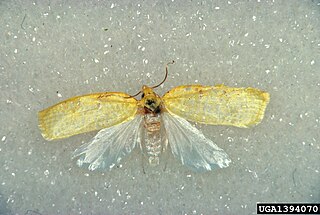
The maple-basswood leafroller is a moth of the family Tortricidae. It is found in eastern North America, from Nova Scotia to Florida, west to Texas.

Fissicrambus mutabilis, the changeable grass-veneer or striped sod webworm, is a moth of the family Crambidae. It is found from Quebec to Florida, west to Texas and Illinois and north to Ontario.
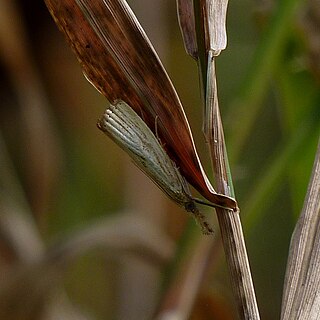
Agriphila vulgivagellus, the vagabond crambus or vagabond sod webworm, is a moth of the family Crambidae. It is found from Quebec and New England to Florida, west to Texas and north to Alberta.

Pediasia trisecta, the large sod webworm or greater sod webworm, is a moth of the family Crambidae. It is found in the United States and southern Canada.
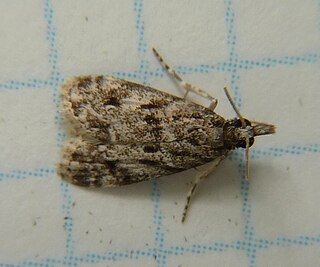
Scoparia basalis, the many-spotted scoparia moth, is a moth of the family Crambidae. It is found in North America, including Arkansas, British Columbia, Georgia, Maine, Massachusetts, New Jersey, Oklahoma, Tennessee, Virginia and Washington.

Urola nivalis, the snowy urola moth, is a moth of the family Crambidae. It is found from southern Canada and Maine, south to Florida and west to Illinois and Texas.

Pyrausta acrionalis, the mint-loving pyrausta moth, is a moth of the family Crambidae. It is found in eastern North America, including Alabama, Georgia, Massachusetts, Mississippi, New Hampshire, New York, Ontario, Tennessee, West Virginia and Wisconsin.

Galasa nigrinodis, the boxwood leaftier moth or boxwood webworm, is moth of the family Pyralidae. It is found in eastern North America.

Sciota subcaesiella, the locust leafroller moth, is a species of moth of the family Pyralidae. It is found in North America, including Maryland, New Jersey, Oklahoma, Iowa, North Carolina, South Carolina, Georgia, Alabama, Mississippi, Maine, New Hampshire, New York, Massachusetts, Pennsylvania, the District of Columbia, Virginia, Tennessee, Illinois, Missouri, Arkansas, Nova Scotia and Ontario.

Evergestis rimosalis, commonly known as the cross-striped cabbageworm, is a species of moth in the family Crambidae. It is found in most of the eastern United States.

Dioryctria reniculelloides, the spruce coneworm, is a moth of the family Pyralidae. The species was first described by Akira Mutuura and Eugene G. Munroe in 1973. It is found from Nova Scotia to Alaska, south in the east to New York, and south in the west to California and New Mexico. It was recorded from China in 2009. Occasionally abundant, often in conjunction with epidemics of the spruce budworm, the spruce coneworm occurs through most or all of the range of spruce in North America, feeding on new foliage and cones of spruce, and often balsam fir. When abundant, it can be a serious pest "particularly on white spruce".
Prionapteryx nebulifera, the clouded veneer moth, is a moth in the family Crambidae. It was described by Stephens in 1834. It is found in North America, where it has been recorded from Florida, Georgia, Maryland, Michigan, New Hampshire, Ontario, South Carolina and Wisconsin.
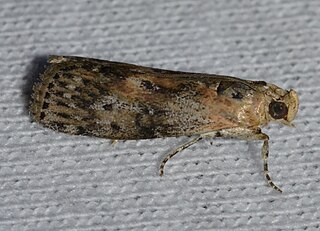
Sciota virgatella, the black-spotted leafroller moth, is a species of snout moth in the genus Sciota. It was described by James Brackenridge Clemens in 1860. It is found in North America, where it has been recorded from Arkansas, Florida, Georgia, Illinois, Indiana, Maine, Maryland, Massachusetts, Minnesota, New Jersey, New York, North Carolina, Ohio, Oklahoma, Ontario, Pennsylvania, Quebec, South Carolina, Tennessee, Texas, Virginia and West Virginia.
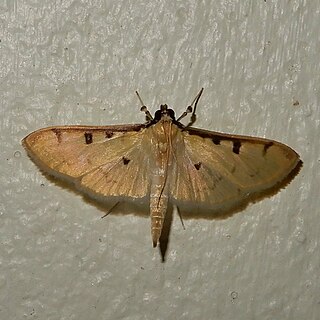
Lygropia tripunctata, commonly known as the sweetpotato leafroller, is a species of moth in the family Crambidae. It was first described by Johan Christian Fabricius in 1794. It is found in the United States, where it has been recorded from Texas to South Carolina and Florida. It is also found from the West Indies and Central America to Brazil.















